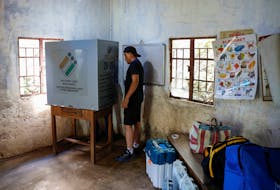TRURO, N.S.
A new initiative will help Nova Scotia farmers assess risks and grow their business.
Bill Casey, MP for Cumberland-Colchester, announced Friday a $1-million investment to develop a dynamic risk assessment tool.
“It is $1 million for the federation to use as they see fit,” Casey told the Nova Scotia Federation of Agriculture’s annual general meeting. He made the announcement on behalf of Lawrence MacAulay, minister of agriculture and agri-food.
“The thing I like about it is, it’s flexible, and they could use it on risk assessment for disease, marketing, climate change, a whole host of things. The federation knows the needs better than anyone.”
The investment was made through AgriRisk, a $60-million program under Growing Forward 2 – Business Risk Management that provides funding to support the development of new risk management tools and services.
While the announcement is new, the investment was approved in January, and work on the dynamic risk assessment tool has been ongoing since.
The tool is being built for the province’s agricultural sector, and is focusing on grape growers and the wine sector during development, due to the sectors manageable size and growing industry in Nova Scotia.
“What the tool does is allow you to sit down and examine risk scenarios associated with climate change predominately, as that is one of the driving forces behind this project,” said Meredith Flannery, AgriRisk project manager for the NSFA.
“It will provide an opportunity to look at where grapes grow now, but also look and see if the conditions in 30 to 50 years will allow them to grow then, as well.”
The project will develop a Grape Suitability Map, to show where grapes will grow, given changing climate.
“There is also another component of the project, which is focusing on dykes, since they’re a vulnerability,” said Flannery.
“That component looks at what the probability of overtopping or breaking dykes is. It takes a look at different risk factors dykes face, and combines those in a way that gives an estimated probability of the likelihood of overtopping.”
The dyke land component will lead to the creation of an interactive risk assessment tool that will allow people to interact with different risks and outcomes associated with certain dyke lands both now and in the future.
While the project focuses on grapes, Flannery feels the tools being developed could be valuable to other sectors as well, as climate change will affect the entire agriculture sector.
“It’s a way of testing out various risk scenarios,” she said.
“Farmers and growers will know what those scenarios are, what worries them in respect to climate change. This will allow them to look at those worries and see how it will potentially affect their crops.”
Climate change creates more challenges
Global warming is changing the agriculture sector and the threat it presents to growers in Nova Scotia is becoming more evident.
“Last week, some farmers around the Bay of Fundy came to me concerned their dykes are at the very edge of collapse,” Cumberland-Colchester MP Bill Casey told the NSFA annual meeting.
“For farmers, if that dyke breaks, that land is ruined. All it would take is one load of salt water. The United Nations has identified the Bay of Fundy as one of two vulnerable areas for rising sea levels, and we have huge challenges there with that.”
Those challenges not only include the effect on the province’s farming industry, but also its transportation sector.
Currently, a two- to three-km. stretch of the CN Railway near the Bay of Fundy is acting as a breakwater and holding back the sea line, a task it was never created to do.
“Halifax is a very successful container port. They bring in 400,000 containers a year, and every single one goes down the rail line across the (entirety) of Nova Scotia toward Chicago,” said Casey.
“If that rail line were to ever let go, not only will the connection to Nova Scotia and Newfoundland be broken, but thousands of acres will be destroyed with salt water inundation.”









